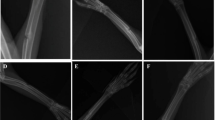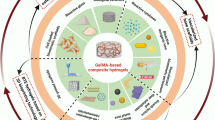Abstract
Bone repair is one of the major challenges facing reconstructive surgery. Bone regeneration is needed for the repair of large defects and fractures. The ability of TGF-β1 and IGF-1 incorporated into hydrogel scaffold to induce bone regeneration was evaluated in a rat tibia segmental defect model. External fixation was performed prior to the induction of the segmental bone defect in order to stabilize the defect site. Hydrogel scaffold containing either TGF-β, IGF-1, TGF-β + IGF-1, hydrogel containing saline or saline, were inserted in the defect. Calcified material was observed in the defects treated with TGF-β 2 weeks following the start of treatment. Bone defects treated with TGF-β, IGF-1 or TGF-β + IGF-1 revealed significant bone formation after 4 and 6 weeks when compared to the control specimens. X-ray images showed that solid bone was present at the defect site after 6 weeks of treatment with TGF-β or TGF-β + IGF-1. A less pronounced bone induction was observed in the control specimens and bones treated with IGF-1. Percent closure ratio of bone defects after 6 weeks were 40, 80, 89, and 97% for saline, hydrogel, IGF-1, TGF-β and IGF-1 + TGF-β groups, respectively. It is concluded that hydrogel scaffold can serve as a good osteoconductive matrix for growth factors, and that it provides a site for bone regeneration and enhances bone defect healing and could be used as alternative graft material.
Similar content being viewed by others
References
Augat P., Margevecius K., Simon J., Wolf S., Suger G. and Calaes L. 1998. Local tissue properties in bone healing: in. uence of size and stability of the osteotomy gap. J. Orthop. Res. 16:475–481.
Ben-Ari A., Volpin G., Silbermann M., Sela J. and Stein H. 1995. An external xation device for immobilization of experimental fractures in tibiae of rats. J. Orthop. Surg. Tech. 6:47–54.
Bosch C., Melsen B. and Gibbons R. 1996. Human recombinant transforming growth factor-b in healing of calvarial bone defects. J. Craniofac. Surg. 7:300–310.
Cook S. D., Wolfe M. W. and Salkeld S. L. 1995. Effect of recombinant human osteogenic protein-1 on healing of segmental defects in non-human primates. J. Bone Joint Surg. 77(A):734–750.
Einhorn T. 1999.Clinically applied models of bone regenera-tionin tissue engineering research. Clin. Orthop. 367:S59–S67.
Fialkov J. A., Holy C. E., Shoichet M. S. and Davies J. E. 2003. In vivo bone engineering in rabbit femur. J. Craniofac. Surg. 14:324–332.
Gerhart T. N., Kirker-Head C. A., Kriz M. J., Holtrop M. E., Henning G. E., Hipp J., Schelling S. H. and Wang E. 1993. Healing segmental femoral defects in sheep using recombinant human bone morphogenetic protein. Clin. Orthop. Rel. Res. 293:317–326.
Gombotz W. R., Pankey S. C. and Bouchard L. S. 1994. Stimu-lation of bone healing by transforming growth factor-beta 1 released from polymeric or ceramic implants. J. Appl. Biomater. 5:141–150.
Hong L., Tabata Y., Miyamoto S., Yamamoto M., Yamada K., Hashimoto N. and Ikada Y. 2000. Bone regeneration at rabbit skull defects treated with transforming growth factor-b incorporated into hydrogels with different levels of biodegradability. J. Neurosurg. 92:315–325.
Kenley R. A., Yim K. and Abrams J. 1993. Biotechnology and bone graft substitutes. Pharm. Res. 10:1393–1401.
Lee S. C., Shea M., Battle M. A., Kozitza K., Ron E., Turek T., Schaub R. G. and Hayes W. C. 1994. Healing of large seg-mental defects in rat femurs is aided by RhBMP-2 in PLGA matrix. J. Biomed. Mat. Res. 28:1149–1156.
Lind M., Schumacher B., Soballe K., Keller J., Melsen F. and Bunger C. 1993. Transforming growth factor-b enhances fracture healing in rabbit tibia. Acta Orthop. Sacnd. 64:553–556.
Lind M., Soren O., Nguyen T., Ongpipattannkul B., Bunger C. and Soballe K. 1996a. Transforming growth factor beta stimulates bone ongrowth to hydroxyapatite coated implants in dogs. Acta Orthop. Scand. 67:611–616.
Lind M., Soren O., Nguyen T., Ongpipattannkul B., Soballe K. and Bunger C. 1996b. Transforming growth factor beta enhances xation and bone ongrowth of ceramic coated implants. J. Orthop. Res. 14:343–350.
Moxham J. P., Kibblewhite D. J., Dvorak M., Perey B., Tencer A. F., Bruce G. and Strong M. 1996. TGF-b forms functionally normal bone in a segmental sheep tibial diaphyseal defect. J. Otolaryngol. 25:388–392.
Robey P. G., Young M. F., Flanders K. C., Roche N. S., Kondaiah P., Reddi A. H., Termine J. D., Sporn M. B. and Roberts A. B. 1987. Osteoblasts synthesize and respond to transforming growth factor-type b (TGF-b in vitro. J. Cell Biol. 105:457–463.
Rodan G. and Martin J. 2000. Therapeutic approaches to bone diseases. Science 289:1508–1514.
Schaefer D., Martin I., Jundt G., Sedel J., Herber M., Grodzinsky A., Bergin I., Vunjak-Novakotic G. and Freed A. 2002. Tissue-engineered composites for the repair of large osteochondral defects. Arth. Reum. 46:2524–2534.
Schmitz J. P. and Hollinger J. O. 1986. The critical size defect as an experimental model for craniomandibular nonunions. Clin. Orthop. Rel. Res. 205:299–308.
Service R. F. 2000. Tissue engineers build new bone. Science 289:1498–1550.
Sherris D., Murakami C. S., Larrabee Jr. W. F. and Bruce A. G. 1998. Mandibular reconstruction with transforming growth factor-b Laryngoscope 108:368–372.
Suliman I. A., Elhassan A. M., Adem A., El-Bakri N. K. and Lindgren J. U. 2001. Changes in tissue levels of growth hormone, insulin-like growth factor-I, and somatostatin in the femurs of hind-limb immobilized rats. Acta Orthop. Scand. 72:186–191.
Tabata Y., Yamada K., Miyamoto S., Nagata I., Kikuchi H., Ayoama I., Tamura M. and Ikada Y. 1998. Bone regenera-tion by broblast growth factor complexed with biodegradable hydrogels. Biomaterials 19:807–815.
Toung J. S., Griffin A., Ogle R. C. and Lindsay W. H. 1998. Repair of nasal defects using collagen gels containing insulin-like growth factor 1. Laryngoscope 108:1654–1658.
Vehof J. W., Fisher J. P., Dean D., der Waerden J. P., Spauwen P. H., Mikos A. G. and Jansen J. A. 2002. Bone formation in transforming growth factor beta-1-coated porous poly (propylene fumarate)scaffolds. J. Biomat. Res. 60:241–251.
Yamada K., Tabata Y. and Yamamoto K. 1997. Potential e. cacy of basic broblast growth factor incorporated in biodegradable hydrogel for skull bone regeneration. J. Neu-rosurg. 86:871–875.
Yamamoto M., Tabata Y., Hong L., Miyamoto S., Hashimoto N. and Ikada Y. 2000. Bone regeneration by transforming growth factor b released from a biodegradable hydrogel. J. Control Rel. 64:133–142.
Yamamoto M., Tabata Y. and Ikada Y. 1998. Ectopic bone formation induced by biodegradable hydrogels incorporating bone morphogenetic protein. J. Biomater. Sci. Polym. 9:439–458.
Yasko A. W., Lane J. M., Fellinger E. J., Rosen V., Wozney J. M. and Wang E. 1992. The healing of segmental bone defects, induced by recombinant human bone morphogenetic protein (rhBMP-2). Bone Joint Surg. 74(A):659–670.
Tarantolo D. J., Sonis S. T., Thompson B. M., Wise D. L., Lewandrowski K. U. and Hile D. D. 2003. Evaluation of a porous, biodegradable biolpolymer sca. old for mandibular reconstruction. Int. J. Oral Maxillofac. Implants 18:182–188.
Zambonin G., Camerino C., Greco G., Patella V., Moretti B. and Grano M. 2000. Hydroxyapatite coated with hepatocyte growth factor (HGF)stimulates human osteoblasts in vitro. Bone Joint Surg. 82(B):57–460.
Author information
Authors and Affiliations
Rights and permissions
About this article
Cite this article
Srouji, S., Blumenfeld, I., Rachmiel, A. et al. Bone defect repair in rat tibia by TGF-β1 and IGF-1 released from hydrogel scaffold. Cell Tissue Banking 5, 223–230 (2004). https://doi.org/10.1007/s10561-004-0503-7
Issue Date:
DOI: https://doi.org/10.1007/s10561-004-0503-7




